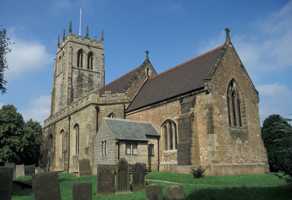 GreasleySt MaryNewark Archdeaconry Newstead Deanery Introduction
St Mary’s church at Greasley has a history stretching back to the
11th century, there being mention of a church in the Domesday Book. The only
remains of the medieval building are a few stones in the east wall. The tower
dates to the 15th century but the nave and choir were subject to several rebuilds,
the last substantial one being in 1896 as a consequence of structural damage
caused by mining subsidence from local collieries.
The church is situated on high ground and the imposing and substantial tower
forms a landmark which can be seen from much of the parish, and its bells heard
throughout the parish.
The present day church interior is light, friendly and presents the visitor
with a warm welcoming feeling. It contains interesting stained glass windows
depicting the history of the church and some of its parishioners. The coloured
windows were first inserted in 1948 when the East window had a War Memorial
commemorative window inserted. However, the ‘Beauvale’ window,
which commemorates St Mary’s connection with Beauvale Priory, the
ruins of which are on private property close to the church, contains two roundels
of medieval glass depicting St Agatha and St Lucy, which came from
the Priory. There are some fine modern coloured windows dedicated to members
of the congregation.
The graveyard contains the grave of Benjamin Drawater who was ship’s
surgeon on one of Captain Cook’s voyages.
St. Mary’s serves a large, vibrant and thriving community, with many
activities provided for its congregation and parishioners, as can be immediately
realised from a glance through the very well produced parish magazine. Visitors
to its services are made very welcome. The church has a long and interesting
history of serving its community and continues to do so in a manner well suited
to the needs of the 21st century inhabitants of Greasley parish.
Particular thanks to Howard Fisher for research on this entry
|